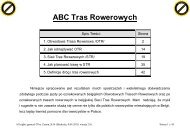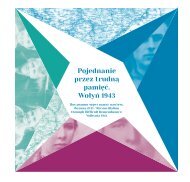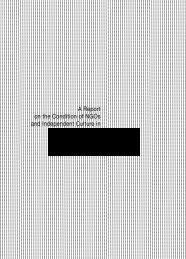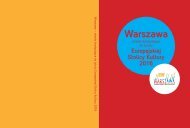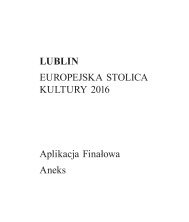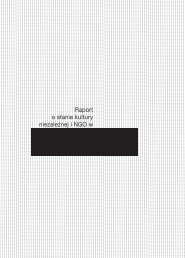Lublin 2016 â Appendix - Kultura Enter
Lublin 2016 â Appendix - Kultura Enter
Lublin 2016 â Appendix - Kultura Enter
Create successful ePaper yourself
Turn your PDF publications into a flip-book with our unique Google optimized e-Paper software.
1. Space for culture,<br />
that is, providing space for a Dialogue of Cultures, is for us both the room for cultural activity and the<br />
cultural values of the urban space - the meanings inherent in this space. At the same time, we acknowledge<br />
that the universal qualities of this space should be: public security, cleanliness and aesthetics.<br />
Cultural Development<br />
Strategy<br />
The operational objectives set out in this area are:<br />
1.1 To improve the working conditions and quality of space for cultural institutions - this includes<br />
investment in new facilities, also the provision by the municipality of vacant public locations<br />
and sites for cultural activity; further, there is the gradual renovating and equipping of cultural sites<br />
coupled with their proper maintenance and care for artistic expression<br />
1.2 Qualitative development of the historic part of <strong>Lublin</strong>- this will not only contribute to the protection<br />
and preservation of historical monuments, but also ensure its vitality and attractiveness of<br />
function; it will harmoniously supplement the missing urban tissue, improve public spaces and<br />
make their history come into view; on top of that, it will help take care of the greenery and ecological<br />
conditions<br />
1.3 To improve the visual integrity of the city and its cultural landscape - this goal aims to enhance<br />
the aesthetics of public spaces, protect the urban skylines and their exposure, expose the natural<br />
lie of the land through wise development and reclamation of green areas, particularly in river<br />
valleys and ravines meandering through the city and shaping its positive ecological conditions<br />
1.4 To introduce art in the public urban space - it will facilitate regular, common and almost involuntary<br />
contact with culture, while pursuing other routines. This goal also covers the establishment<br />
of small enclaves of retreat (inspired by the projects such as “oxygenation”), permitting<br />
short breaks and momentary relaxation, which is particularly important in the vicinity of the busiest<br />
parts of the city, but also near one’s home.<br />
1.5 To furnish the conditions for recreation and outdoor activity - this can be done in river valleys<br />
and ravines taken over for social and artistic activities; local residents will be involved in shaping<br />
their own surroundings under a long-term Green Connection programme. It is also important<br />
here to create space for the so-called “backyard recreation”, which is safe and integrates residents<br />
in different age near their own place.<br />
1.6 To improve the spatial quality of visitors’ “first contact” sites in <strong>Lublin</strong> - this relates to railway<br />
stations, transit routes, bus stops; if some artistic values were added there, this would alter<br />
the image of <strong>Lublin</strong><br />
1.7 To create a culture of dialogue around the shaping of space - such a goal can be achieved by<br />
making the spatial planning process a citizens’ issue and by opening to civic initiatives when deciding<br />
on changes within the urban setting (social consultation of both investments and ideas for<br />
the management of shared spaces)<br />
2. Participation in culture,<br />
is understood as the shaping of needs and development of skills in cultural reception to the widest extent<br />
possible, including individuals and communities threatened by exclusion; this goal also aims to increase<br />
artists’ and cultural operators’ competence. Broad participation in culture is particularly important<br />
for the success of the ECC <strong>2016</strong> bid, considering the fact that its programme is hinged on dialogue.<br />
The operational objectives set out in this area are:<br />
2.1 To develop cultural participation habits - this is particularly vital for children and young people,<br />
especially the large community of the <strong>Lublin</strong> students, but also groups and communities at<br />
risk of social exclusion, including a sizeable group of senior citizens; such citizens have a lot of<br />
free time and their life experience (so often ignored) should be particularly valued and shared.<br />
78



